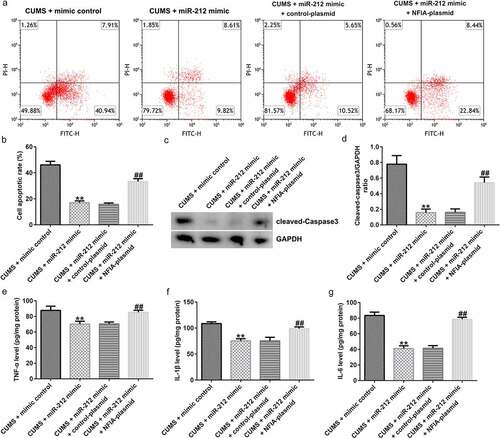Figures & data
Figure 1. Expression of miR-212 in CUMS mice. The expression level of miR-212 in peripheral blood samples (a) and hippocampus tissues (b) in CUMS mice was determined using quantitative reverse transcription (qRT)-PCR. **p < 0.01 vs. Control group. CUMS, Chronic unpredictable mild stress
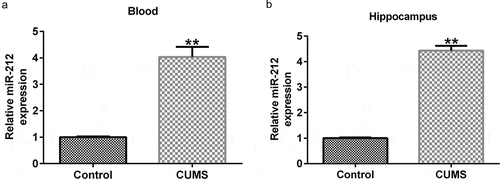
Figure 2. miR-212 mitigates body weight loss and depression-like behaviors in CUMS-induced mice. (a) Expression of miR-212 in hippocampal tissues of mice after treatment with miR-212 mimic was measured using quantitative reverse transcription (qRT)-PCR. (b) Body weight of mice in different groups. (c) miR-212 mimic improves the sucrose preference in CUMS model. (d) miR-212 mimic shortens the immobility in forced swimming test in CUMS mice. (e) miR-212 mimic reduces the immobility in tail suspension test in CUMS mice. **p < 0.01 vs. Control group; ##p < 0.01 vs. CUMS+mimic control group. CUMS, Chronic unpredictable mild stress

Figure 3. miR-212 ameliorates CUMS-induced neuronal cell apoptosis and inflammation response in the hippocampus. (a-b) Cell apoptosis rate measured by flow cytometry analysis. (c-d) Cleaved-Caspase3 expression levels and cleaved-Caspase3/GAPDH ratio in CUMS mice after treatment with miR-212 mimic or FLU were detected by Western blot assay. Expression levels of TNF-α (e), IL-1β (f), and IL-6 (g) in CUMS hippocampus were evaluated using ELISA. **p < 0.01 vs. Control group; ##p < 0.01 vs. CUMS+mimic control group. CUMS, Chronic unpredictable mild stress; FLU, fluoxetine; IL-1β, interleukin-1β; Il-6, interleukin-6; TNF-α, tumor necrosis factor-α
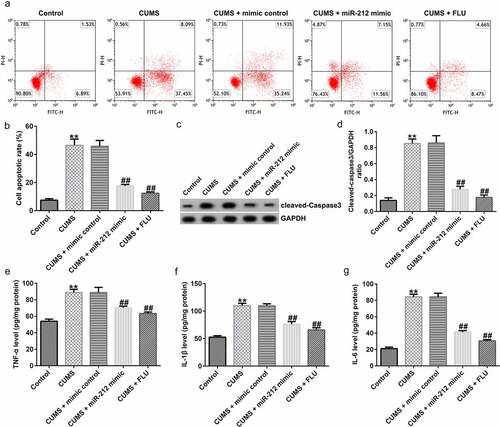
Figure 4. NFIA is a downstream target of miR-212. (a) Potential binding sites between NFIA and miR-212 were predicted by the TargetScan online tool. (b) miR-212 level in 293 T cells transfected with mimic control or miR-212 mimic was measured using quantitative reverse transcription (qRT)-PCR. (c) Dual-luciferase reporter assay confirmed the targeted relationship between miR-212 and NFIA. **p < 0.01 vs. mimic control group
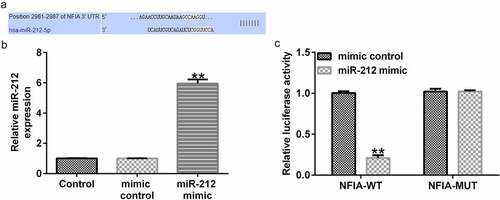
Figure 5. NFIA is negatively regulated by miR-212 in CUMS-induced mice. (a) NFIA protein expressions in CUMS mice with or without miR-212 mimic treatment were determined by Western blotting. (b) NFIA mRNA expression levels in CUMS-induced mice with or without miR-212 mimic treatment were detected by quantitative reverse transcription (qRT)-PCR analysis. **p < 0.01 vs. Control group; ##p < 0.01 vs. CUMS+mimic control group. CUMS, Chronic unpredictable mild stress
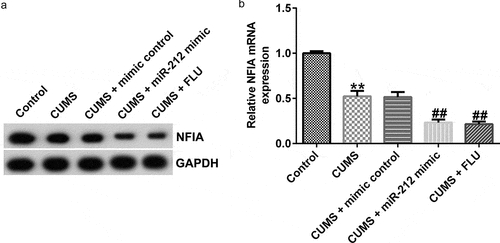
Figure 6. miR-212 ameliorates depression-like behaviors in CUMS-induced mice by targeting NFIA. (a) Protein expression levels of NFIA in different CUMS groups. (b) NFIA mRNA expressions levels in different CUMS groups. (c) NFIA overexpression reduces the sucrose preference in CUMS mice when compared with those treated with miR-212 mimic. (d-e) NFIA worsens the immobility time in forced swimming and tail suspension tests in CUMS mice when compared with the miR-212 mimic + control-plasmid treatment group. **p < 0.01 vs. CUMS + mimic control group; ##p < 0.01 vs. CUMS + miR-212 mimic + control-plasmid group. CUMS, Chronic unpredictable mild stress
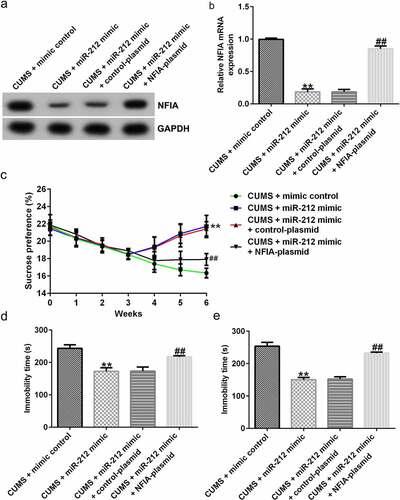
Figure 7. miR-212 suppresses neuronal cell apoptosis and inflammation response in CUMS hippocampus by targeting NFIA. (a-b) Cell apoptosis rate in different groups. (c-d) Cleaved-Caspase3 and cleaved-Caspase3/GAPDH3 ratio were determined by Western blotting. (e-g) Concentrations of TNF-α, IL-1β, and IL-6 in CUMS hippocampus were evaluated by ELISA. **p < 0.01 vs. CUMS + mimic control group; ##p < 0.01 vs. CUMS + miR-212 mimic + control-plasmid group. CUMS, Chronic unpredictable mild stress; IL-1β, interleukin-1β; Il-6, interleukin-6; TNF-α, tumor necrosis factor-α
